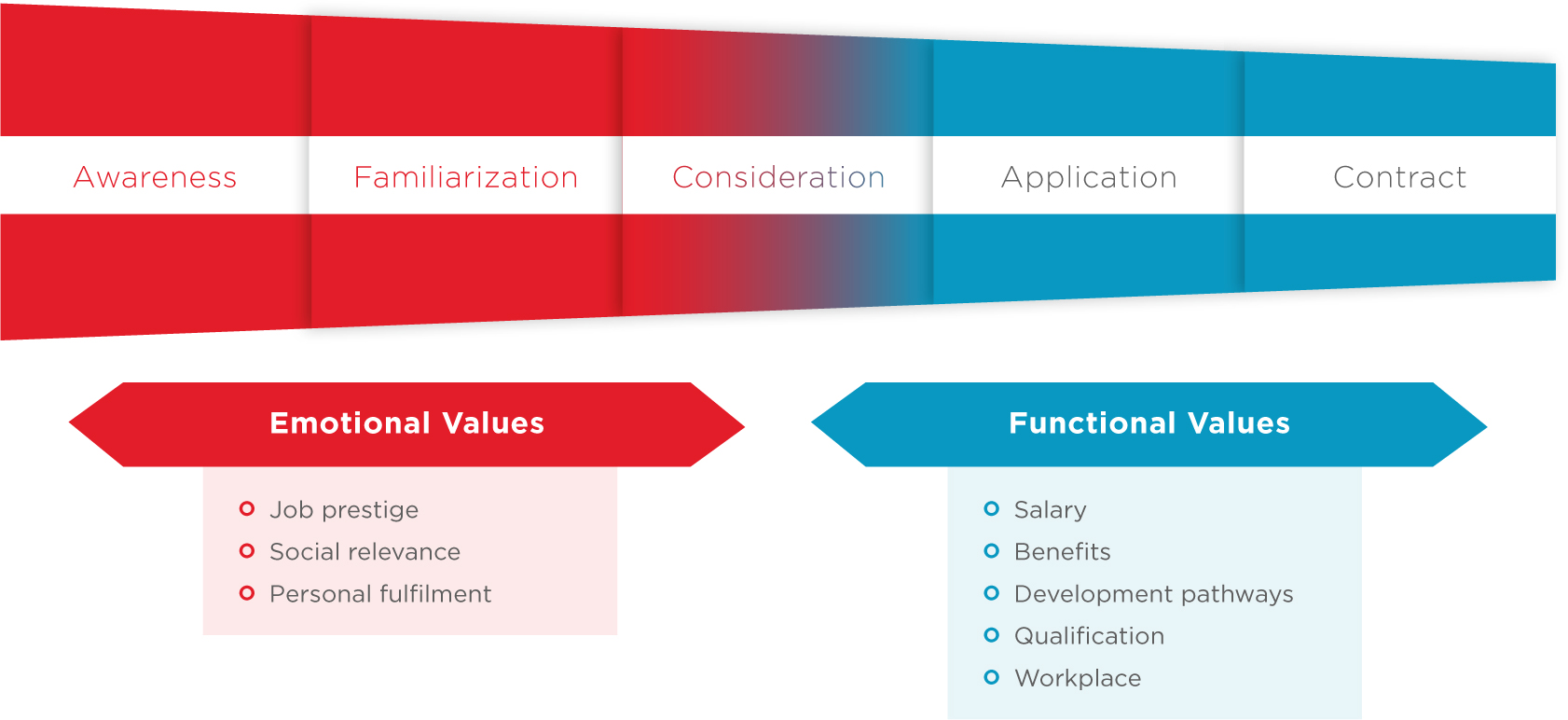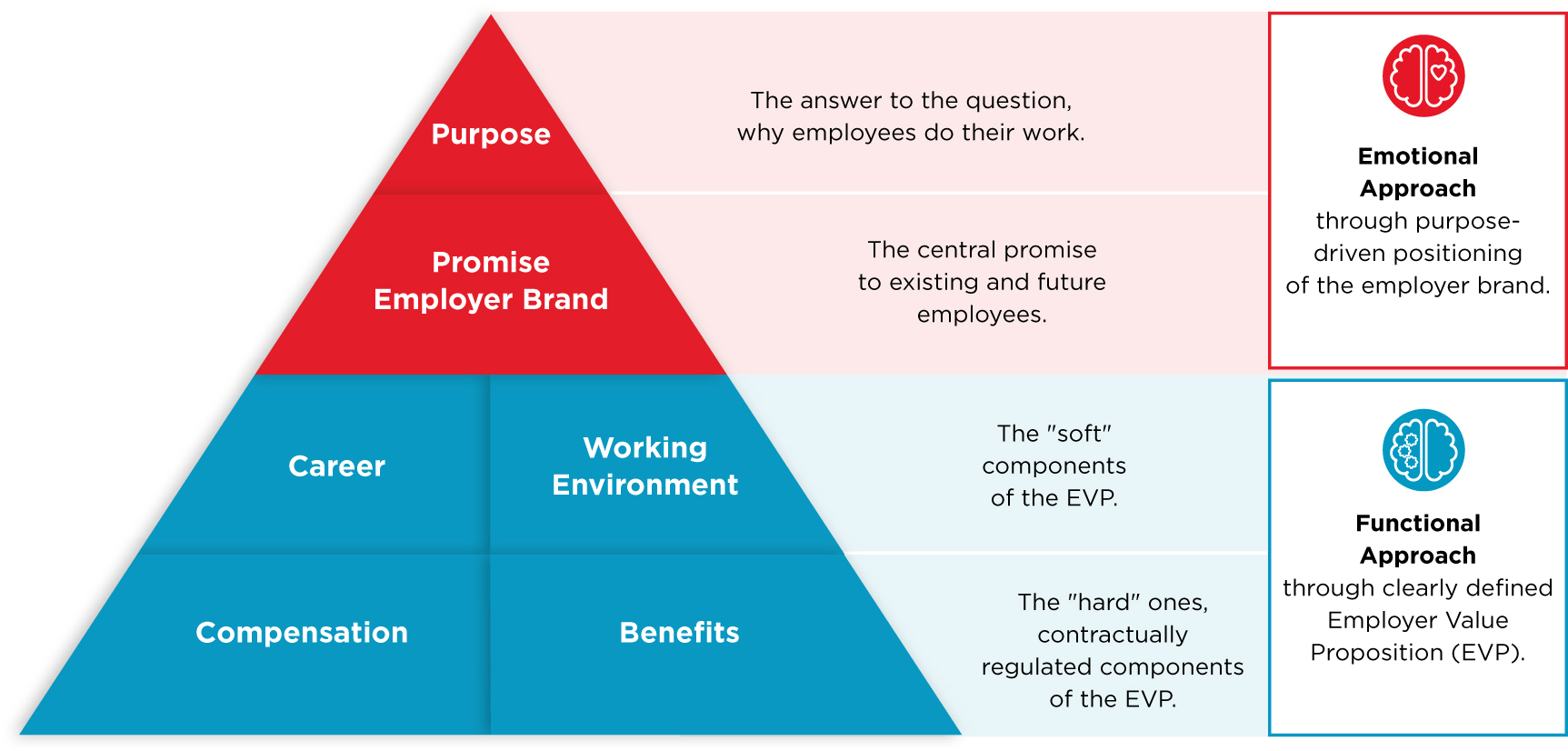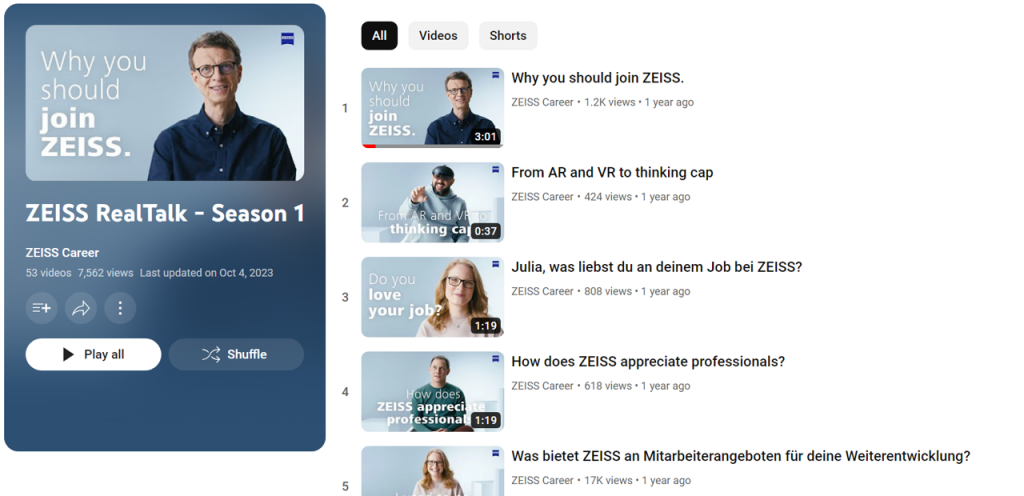Employer Branding: Attracting and retaining talent with purpose
In times of skills shortages, purpose is an effective vehicle for attracting and retaining employees. Common employer value proposition (EVP) models often neglect the potential of a strong corporate purpose for employee attraction and employer branding.

“Landed and not in the mood for work tomorrow?” Passengers arriving at Stuttgart Airport in late summer 2023 could not miss the large advertising posters of the Baden-Württemberg Ministry of Culture with the provocative question. “Hurraaa! Do what you love and become a teacher,” the campaign continued. The Ministry of Education‘s posters were apparently intended to promote the teaching profession, but caused great outrage among teachers‘ associations.
The unsuccessful campaign is a good example of how employer branding that is clearly not linked to a purpose can fizzle out without the desired effect and even damage the reputation of the entire brand. Yet the teaching profession is actually one in which the meaningful element is obvious: Accompanying young people as they grow up and encouraging them to become a pillar of our society in the future.
The challenges of a shortage of skilled workers and the search for meaning
The example shows that a “meaningful” employer presence is now a question of competitiveness for the best talent – especially in a labor market that has changed from an employer market to an employee market in view of the ongoing shortage of skilled workers. The old days of a glut of applicants are over; instead, companies in most sectors have been competing for qualified workers for several years now. Many companies have long recognized the shortage of skilled workers as a strategic risk, and a strong employer positioning is gaining considerably in importance. This is because what applicants are looking for has also changed significantly. Younger applicants in particular are now looking for employers whose goals they can identify with. Their work should give them the feeling that they are doing something meaningful.
Younger generations in particular, such as Generation Y (those born after 1980) and Generation Z (those born after 1994), have proven to place high value on the impact of their own actions. They expect social commitment from the economy and therefore also from the companies in which they work. Companies that enable young talents to identify with the company and its purpose will find it easier to find suitable employees and retain them for the long term.
These are the new expectations of employers
Meaningfulness as a competitive factor in the “war for talent”

Employees in the USA state that they would give up money if it made their job more meaningful1

of millennials expect their employers to address social and environmental issues2

of employees have “internally resigned” and describe themselves as “not committed”3
Purpose is becoming a differentiating value for employer branding and positioning.
1 9 Out of 10 People Are Willing to Earn Less Money to Do More-Meaningful Work (2018), Harvard Business Review; 2 Purpose is Everything (2020), Deloitte; 3 State of the Global Workplace 2023 Report (2023), Gallup.
Purpose promotes employee loyalty and performance
Once employees have found an employer that meets the criterion of meaningful activity, they are more likely to remain loyal. This is partly due to the fact that socially relevant engagement promotes employee loyalty. Research by Heidrick & Struggles found that 73 percent of employees who say they work at a purpose-driven company feel engaged, compared to only 23 percent of those who do not.

Employer branding – How to address talent in the right way
In the modern world of work, it is crucial in talent acquisition to approach potential specialists at the right time and in the right way. If companies do not address the needs of potential candidates, this can severely impair the effectiveness of their recruitment efforts.
In the first part of the recruitment funnel, which focuses on the “awareness” and “familiarization” phases, applicants should be addressed primarily on an emotional level. In these early phases, the aim is to arouse interest and curiosity among potential candidates. The “purpose” – the socially relevant purpose of the company – plays a decisive role here. Applicants, as we have already seen, are often looking for a deeper meaning in their work. They want to be part of a company that represents values they can identify with and that has a positive impact on society or the industry.
Employer branding that focuses on storytelling, corporate culture and the communication of values and visions is particularly effective in this phase.
In the second phase of the funnel, which comprises the steps “Consideration”, “Application” and “Contract”, the focus shifts to the functional level. At this stage, applicants are already emotionally engaged and begin to evaluate more concrete aspects of the potential job. Here it is the specific “benefits” or advantages of the position that come to the fore. Aspects such as salary, career development opportunities, workplace environment, work-life balance, benefits and training opportunities become more important. Companies should provide clear, detailed information about these functional aspects at this stage to help candidates make an informed decision.

It is crucial for companies to be aware of the different needs and expectations of candidates at different stages of the recruitment funnel. A balanced combination of emotional appeal by communicating the company’s purpose and functional information about specific job benefits is the key to successful talent acquisition and building a strong employer brand.
The unity of positioning and employer branding is so important
How do you create employer branding that really suits the company and promises longterm success? The solution: Employer branding and corporate positioning with a purpose must be brought into harmony with one another. Companies must speak with one voice instead of running individual applicant campaigns in employer branding that are detached from the overall positioning. For this concerted approach, the entire brand must be thought of much more strongly from the perspective of the employer positioning, and employer branding can no longer be seen separately from a purpose-led corporate positioning. Instead, the company should radiate in all directions: We are not only the right match for you as a potential customer, but also the right employer for you as a talent. As a company, we are good for you personally, but we also make a positive contribution to the development of society.
Ideally, this will result in a sustainable positioning as a credible employer brand, the so-called Employer Value Proposition (EVP), which also appeals to talent beyond short-term campaigns. The EVP is the employer’s emotional and functional value proposition to its employees. It describes what current and potential employees have and can expect from working for the organization. The EVP should not be confused with a mere list of benefits such as attractive remuneration or many vacation days. It also includes the cultural level of the company. With the EVP, employers can communicate what makes them unique. They can transparently explain what purpose determines the company’s activities and how cooperation within the organization is structured. And they can focus on what the company wants to achieve in the future with the help of its employees.
The problem: Purpose is neglected in many EVP models
Purpose often does not feature at all in current EVP models or is only a partial aspect, while aspects such as the working environment, career opportunities, pay and benefits dominate as typical building blocks in the models. Purpose, on the other hand, is clearly underrepresented in most of the EVP models used to date. This is no longer in keeping with the times, given the great importance that jobseekers now attach to a sense of purpose.

Globeone has therefore developed a modified EVP model in which the purpose of the company is used to target talent. In contrast, “hard”, contractually regulated components of the EVP such as compensation and benefits are moved down the communication hierarchy, insofar as they only become important for the later phases in the applicant funnel. They form the foundation of the new EVP model. Above this are the “soft” components such as working environment and career, which are important but not decisive in the talent approach. The “hard” and “soft” components together form the functional facts, which all companies generally have to present in different forms when addressing applicants.
The solution: the purpose-centered EVP model
The biggest change in the modified EVP model: In our view, the central promises of the employer brand to existing and future employees and the purpose of the company belong at the top. This purpose provides the answer to why employees do their work and what connects them to the company. The pinnacle of the EVP model is therefore the emotional appeal through purpose-driven positioning of the employer brand.
Our EVP model lays the foundation for an integrated and convincing employer brand & EVP. It integrates purpose as a meaningful element of the corporate brand into the employee & talent approach. It combines the emotional and functional approach to create a holistic employer brand experience. And it creates a common frame of reference for marketing, communication and HR and thus the basis for fruitful collaboration between these areas of the company.
Our plea: Also use purpose for talent approach!

At the same time, our EVP model can serve as the basis for measuring success in employer branding by measuring progress against promises. It offers enough flexibility to map important needs of individual business units, regions and functions if required – which is particularly important for global corporations.
3 Tips for a more effective employer branding strategy & activation
1. Think of the entire brand more in terms of the employer brand and use purpose
- Purpose emphasizes the importance of “meaningful work”; there is great potential in using this for the Employer Value Proposition (EVP) as well. Purpose appeals to the emotional values of talented people who are looking for meaningful work.
- When developing a corporate purpose, care should be taken to ensure that it is also relevant for employees and potential applicants.
- Organizationally, an interface between HR/HR, communications and marketing is important to ensure that the corporate brand and the employer brand are communicated coherently and consistently.
2. Establish a clear hierarchy in the EVP model
- As a first step, it is important to understand the emotional and functional needs of its applicants along the typical stages of an application process.
- Establish a structured sequence of when which employee needs are addressed, differentiated according to emotional and functional aspects. This helps to tailor communications to each stage of the candidate journey and ensure that the right messages are delivered at the right time.
3. Activation through campaigns and communication measures
- Using campaigns and communication strategies that highlight authentic employee stories and showcase their positive contribution to the company.
- Employees who identify with their company and share its values are convincing ambassadors to the outside world. Their stories can touch potential applicants emotionally and convey a realistic picture of everyday working life and the corporate culture.
Authentic approach through programs and campaigns for a strong employer brand
Authenticity is important here: attracting applicants and retaining talent requires a continuous approach through programs and campaigns that contribute to the brand in an authentic, transparent and comprehensible way, express the corporate culture and thus increase attractiveness for applicants and promote employee loyalty.
Employer branding examples: successful employer branding campaigns
LBBW
LBBW launched a mainly digital employer branding campaign in 2023 under the motto #NeuesSchaffen. The brand ambassador is Katharina, Queen of Württemberg and founder of the bank. With this campaign, the company is positioning itself as a sustainable bank and attractive employer that is making its contribution to a strong future in Germany. In doing so, it is following the legacy of Katharina, who ensured progress and growth in the country 200 years ago: in 1818, Katharina, the country’s queen at the time, founded the bank to combat the prevailing famine. She was just 30 years old at the time. Today, she would probably be described as a female founder and young professional. Reason enough for LBBW to give her a voice in order to carry on her legacy and be a role model for others. To achieve this, LBBW brought her founder back to life as an avatar using artificial intelligence.
As a corporate influencer, Katharina von Württemberg has been given a platform on her own LinkedIn account. There she addresses young target groups with topics relating to sustainable change (green economy, modern working world). #NeuesSchaffen is used as a synonym for New Work and stands for culture and community in a future-oriented (“safe bank”) workplace. Many visuals consist of an image and a quote from Katharina that underlines the campaign’s core messages. The key themes and focal points can also be found on LBBW’s revamped careers website.



Rewe


“Get involved and join the REWE clan” is the REWE slogan. The food retailer has often shown itself to be particularly innovative in recruiting in the past and wants to be present with its employer branding where the target group is active. With the campaign “Bring yourself into the game and join the REWE Clan”, REWE is intensifying its approach to gamers. With short social media videos and a wink, the company is drawing attention to its training opportunities in the stores and logistics centers. The message: “We speak your language and can offer you exciting careers that are fun and based on team play. We invite you to be part of our world and use your skills in real life.”
With its campaign, REWE is taking the approach of addressing a relatively small target group that is to be won over to Rewe as an employer through a customized design and language. In addition to YouTube and Twitch as the most important moving image channels for the target group, REWE is also using TikTok, Instagram and X for the digital-only campaign. On TikTok and Instagram, the content is also played out organically on REWE’s own career accounts. Influencers from the gaming scene also support the all-round successful campaign.

ZEISS
Real people. Real stories. How does it feel to work for the ZEISS technology group? In more than 100 short videos in interview format, the “ZEISS RealTalks”, employees from three continents in different professions talk about their specific tasks, their varied working day, innovative projects, but also about their role in the big picture. The accompanying company video letter ensures that employees can interact with the videos on LinkedIn and that the content can go viral organically. The goal: to strengthen the employer brand, create clarity about what ZEISS actually does and convince lots of potential new colleagues to join ZEISS.

The extremely authentic video campaign radiates: “You can make a difference with us! Our employees are proud of their work because they can help people and ensure a better quality of life in everyday.”


Study: The major disconnect between purpose and employer brand
We know from a joint study with the Quadriga University of Applied Sciences Berlin: Purpose in companies is currently driven primarily by top management and those responsible for communication, but hardly at all by HR. This low level of involvement partly explains why purpose has rarely been convincingly linked to employer positioning.
An employer value proposition (EVP) that is developed in isolation from the overarching corporate purpose quickly runs the risk of becoming too narrowly focused on the functional aspects and not fitting seamlessly into the overarching brand positioning.
The clear recommendation in such development processes is therefore to consider the EPP directly as an extension of the corporate purpose.
Even DAX companies are missing out on potential
From our analyses, we know that only around eight percent of DAX 40 companies use their purpose for their employer brand. Their purpose statement and EVP message are identical. Take DHL, for example: “Connecting people, improving lives.” Or adidas: “Through sport, we have the power to change lives.”
For 44 percent of the DAX 40 companies, the employer brand is an indirect continuation of the purpose. Although the messages have more or less evolved, the original purpose is usually still clearly recognizable. Take E.ON, for example: “Your energy shapes the future.” Or Porsche: “Make your dream come true. And with it millions of others.”
For 47% of the DAX 40 companies, however, the purpose does not guide the EPP at all. As a result, the statements from companies such as Merck (“Work your magic with us!”), Daimler Truck (“You make us – you make the difference.”) or Deutsche Bank (“A future that’s yours to shape. What could you do?”) are not linked to the companies’ purpose concepts in their wording.
Conclusion and recommendations
- Employer branding is increasingly becoming a strategic success factor. The positioning of the corporate brand should therefore also be considered more from the perspective of the employer brand!
- If you have developed a strong purpose, be sure to use it for employer branding. Salary and benefits are important when addressing talent, but they are not the only decisive factors. Emotions and purpose are also needed, especially at the beginning of the applicant journey!
- A strong employer brand is not created in a silo of HR, communication or marketing. Collaboration is crucial for a powerful positioning!



